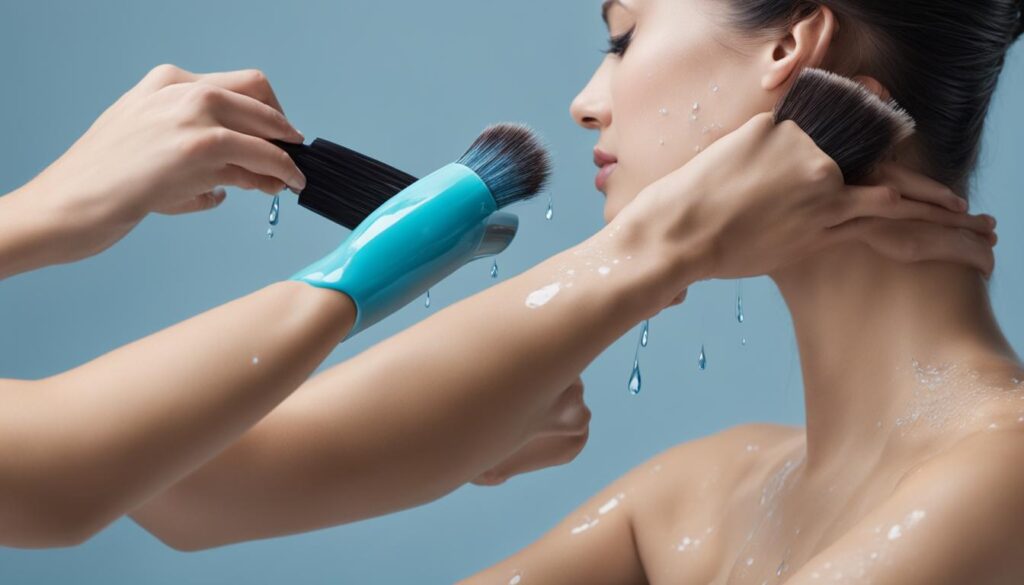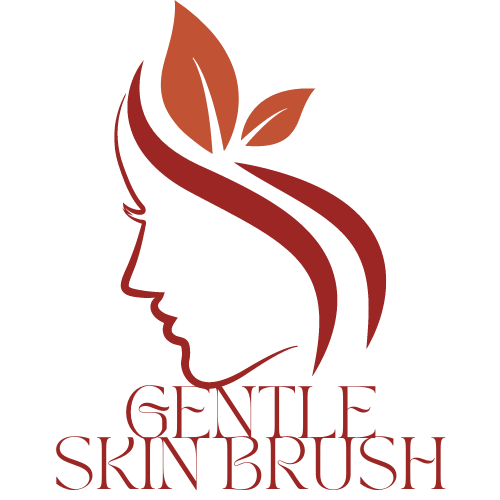Wet body brushing has gained popularity as a quick and easy practice for maintaining healthy skin. While many claim that it provides various health benefits, it’s important to understand the effectiveness and advantages of this technique. Let’s explore the difference between dry brushing and wet brushing, the benefits of wet body brushing, and factors to consider when deciding whether to incorporate this method into your skincare routine.
Contents
Key Takeaways:
- Wet body brushing is a popular practice for maintaining healthy skin.
- Understanding the difference between dry brushing and wet brushing is essential.
- Wet body brushing offers similar benefits to dry brushing.
- The choice between dry brushing and wet brushing depends on individual preferences, skin type, age, and climate.
- Proper skincare hygiene and adjusting the pressure based on skin sensitivity are important when practicing wet body brushing.
What is the Difference Between Dry Brushing and Wet Brushing?
Dry brushing and wet brushing are two popular techniques for exfoliating the skin and improving overall skin health. While they may seem similar, there are some key differences between the two methods. Understanding these differences can help you decide which technique is best suited for your skincare routine.
Dry Brushing
Dry brushing involves using a dry brush to gently exfoliate the skin. This method is typically done before showering or bathing. The dry brush is made of natural fibers and has a long handle that allows you to reach all areas of your body. When dry brushing, start from your feet and brush upwards towards your heart in long, sweeping motions. This technique helps to stimulate circulation, remove dead skin cells, and promote lymph flow. It’s important to use gentle pressure and avoid brushing over any irritated or broken skin. Once you’ve finished dry brushing, take a shower to wash away the loosened dirt and dead cells.
Wet Brushing
Unlike dry brushing, wet brushing is done with the help of water and an exfoliation tool such as a wet skin brush, loofah, or washcloth. Wet brushing is typically incorporated into your showering or bathing routine. To wet brush, use circular motions and start from the top of your body, working your way downwards. It’s important to use a gentle scrubbing motion to avoid damaging the skin. Lukewarm water is recommended to prevent stripping the skin of its natural oils. Additionally, it’s important to regularly replace your exfoliation tool to prevent bacteria growth.
| Dry Brushing | Wet Brushing | |
|---|---|---|
| Tools Used | Dry brush | Wet skin brush, loofah, or washcloth |
| Application | Before showering or bathing | During showering or bathing |
| Motion | Long, sweeping motions towards the heart | Circular motions from top to bottom |
| Pressure | Gentle | Gentle scrubbing |
| Water | Not required | Used as part of the technique |
Both dry brushing and wet brushing have their own unique benefits and can be incorporated into your skincare routine based on personal preference. The choice between the two methods ultimately comes down to individual needs and preferences. Experiment with both techniques and listen to your body to determine which method works best for you, keeping in mind your skin type, age, and climate.
How to Dry Brush Your Skin
Dry brushing is a popular technique for exfoliating the skin and improving circulation. To effectively dry brush your skin, follow these steps:
- Select a natural-fiber brush with a long handle to reach all areas of your body.
- Start at your feet and work your way upwards, using long, sweeping motions.
- Brush in the direction of your heart to promote lymph flow.
- Apply gentle pressure to avoid damaging the skin.
- After dry brushing, take a shower to wash away any loosened dirt and dead skin cells.
Dry brushing should be done on dry skin before showering. It’s important to note that everyone’s skin is different, so adjust the pressure and frequency of dry brushing based on your skin sensitivity and comfort level. Remember to replace your brush regularly to maintain its effectiveness and prevent bacteria growth.
“Dry brushing helps to exfoliate the skin, remove dead cells, and stimulate blood flow,” says dermatologist Dr. Jane Smith. “It can leave your skin feeling smoother and can also help with lymphatic drainage.”
Benefits of Dry Brushing
The benefits of dry brushing include:
- Exfoliation: Dry brushing helps remove dead skin cells, leaving your skin smoother and softer.
- Improved circulation: By stimulating blood flow, dry brushing can help promote healthier skin.
- Lymphatic drainage: Dry brushing can aid in the removal of toxins from the body by stimulating the lymphatic system.
- Reduced cellulite: Although further research is needed, some claim that dry brushing can help reduce the appearance of cellulite.
Remember to always moisturize your skin after dry brushing to keep it hydrated and nourished.
| Pros | Cons |
|---|---|
| Dry brushing provides exfoliation and promotes blood circulation. | Dry brushing may not be suitable for individuals with sensitive or irritated skin. |
| Dry brushing can help with lymphatic drainage and the removal of toxins. | Overbrushing or using too much pressure can cause skin irritation or abrasions. |
| Dry brushing may improve the appearance of cellulite. | Dry brushing may not be recommended for individuals with certain skin conditions. |
How to Wet Brush Your Skin

Wet brushing is a simple and effective technique for exfoliating and revitalizing your skin. By incorporating this method into your skincare routine, you can enjoy the benefits of improved circulation, softer skin, and a radiant complexion. Here are some steps to follow when wet brushing:
Gather the Right Tools
Before you begin wet brushing, make sure you have the appropriate tools. Choose a wet skin brush, loofah, or washcloth that suits your preference. Opt for a tool with gentle bristles or soft material to avoid damaging your skin.
Start from the Top
When wet brushing, it’s best to start from the top of your body and work your way downwards. Begin by gently scrubbing your face in circular motions, then move on to your neck, chest, arms, torso, and legs. Remember to use light to moderate pressure, allowing the brush or washcloth to do the work without causing irritation.
Use Lukewarm Water
While wet brushing, it’s important to use lukewarm water to avoid stripping your skin of its natural oils. Hot water can be too harsh and drying, while cold water may not effectively remove dirt and dead skin cells. Find a comfortable temperature that allows you to thoroughly cleanse your skin without causing discomfort.
Replace Your Tools Regularly
Over time, your wet skin brush, loofah, or washcloth may harbor bacteria or become worn out. To maintain good hygiene and ensure effective exfoliation, make it a habit to replace your tools regularly. This will help prevent any potential skin infections or irritations.
By following these simple steps, you can incorporate wet brushing into your skincare routine and enjoy the benefits of smoother, healthier-looking skin. Remember to listen to your body and adjust the pressure and frequency of wet brushing based on your skin’s sensitivity and needs. With consistent practice, you’ll be able to reap the rewards of this revitalizing technique.
Conclusion
Wet body brushing offers a multitude of benefits for your skin health and overall well-being. This technique, similar to dry brushing, aids in the removal of dirt, oil, and dead skin cells, leaving your skin feeling refreshed and rejuvenated.
One of the advantages of wet body brushing is its detoxification effect. By exfoliating the skin and stimulating circulation, it helps to improve lymph flow and assist in the elimination of toxins from the body. This can be particularly beneficial for individuals with oily skin or those living in humid climates, as it aids in maintaining a balanced and healthy complexion.
When deciding between dry brushing and wet brushing, it’s important to consider your individual preferences, skin type, age, and climate. Both methods offer their own set of benefits, so it’s crucial to listen to your body and choose the technique that works best for you.
Remember, whether you opt for dry brushing or wet body brushing, practicing proper hygiene and adjusting the pressure based on your skin sensitivity are essential. Take care of your skin by incorporating this method into your skincare routine and enjoy the revitalizing effects it provides.
FAQ
What is the difference between dry brushing and wet brushing?
Dry brushing involves using a dry brush on the skin to exfoliate and improve circulation, while wet brushing is done with the help of water and an exfoliation tool like a wet skin brush, loofah, or washcloth during showering or bathing.
How do I perform dry brushing?
Dry brushing is done before showering using a natural-fiber brush with a long handle. Brush the skin in specific motions, starting from the feet and moving upwards in the direction of the heart. Use gentle pressure to avoid skin damage and follow with a shower to wash away loosened dirt and dead cells.
How do I perform wet brushing?
Wet brushing can be done in the shower using a wet skin brush, loofah, or washcloth. Scrub the skin gently in circular motions, starting from the top of the body and working downwards. Use lukewarm water to avoid stripping the skin of its natural oils, and replace the exfoliation tool regularly to prevent bacteria growth.
What are the benefits of wet body brushing?
Wet body brushing, like dry brushing, helps remove dirt, oil, and dead skin cells while stimulating circulation. It can be particularly beneficial for those with oily skin or living in humid climates.
How do I determine whether to dry brush or wet brush?
The choice between dry brushing and wet brushing depends on individual preferences, skin type, age, and climate. Consider these factors and listen to your body to determine which method works best for you.





Leave a Reply